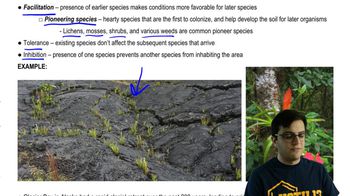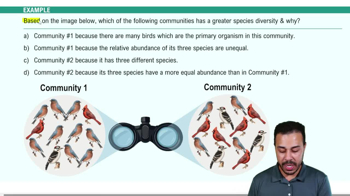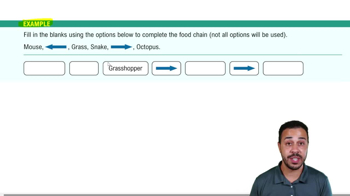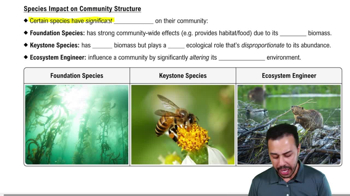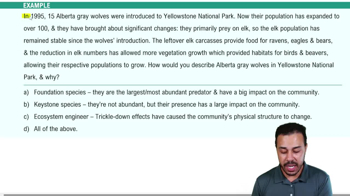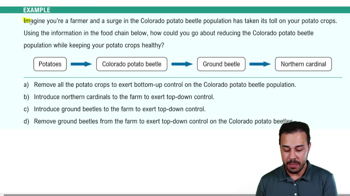Table of contents
- 1. Introduction to Biology2h 42m
- 2. Chemistry3h 40m
- 3. Water1h 26m
- 4. Biomolecules2h 23m
- 5. Cell Components2h 26m
- 6. The Membrane2h 31m
- 7. Energy and Metabolism2h 0m
- 8. Respiration2h 40m
- 9. Photosynthesis2h 49m
- 10. Cell Signaling59m
- 11. Cell Division2h 47m
- 12. Meiosis2h 0m
- 13. Mendelian Genetics4h 44m
- Introduction to Mendel's Experiments7m
- Genotype vs. Phenotype17m
- Punnett Squares13m
- Mendel's Experiments26m
- Mendel's Laws18m
- Monohybrid Crosses19m
- Test Crosses14m
- Dihybrid Crosses20m
- Punnett Square Probability26m
- Incomplete Dominance vs. Codominance20m
- Epistasis7m
- Non-Mendelian Genetics12m
- Pedigrees6m
- Autosomal Inheritance21m
- Sex-Linked Inheritance43m
- X-Inactivation9m
- 14. DNA Synthesis2h 27m
- 15. Gene Expression3h 20m
- 16. Regulation of Expression3h 31m
- Introduction to Regulation of Gene Expression13m
- Prokaryotic Gene Regulation via Operons27m
- The Lac Operon21m
- Glucose's Impact on Lac Operon25m
- The Trp Operon20m
- Review of the Lac Operon & Trp Operon11m
- Introduction to Eukaryotic Gene Regulation9m
- Eukaryotic Chromatin Modifications16m
- Eukaryotic Transcriptional Control22m
- Eukaryotic Post-Transcriptional Regulation28m
- Eukaryotic Post-Translational Regulation13m
- 17. Viruses37m
- 18. Biotechnology2h 58m
- 19. Genomics17m
- 20. Development1h 5m
- 21. Evolution3h 1m
- 22. Evolution of Populations3h 52m
- 23. Speciation1h 37m
- 24. History of Life on Earth2h 6m
- 25. Phylogeny2h 31m
- 26. Prokaryotes4h 59m
- 27. Protists1h 12m
- 28. Plants1h 22m
- 29. Fungi36m
- 30. Overview of Animals34m
- 31. Invertebrates1h 2m
- 32. Vertebrates50m
- 33. Plant Anatomy1h 3m
- 34. Vascular Plant Transport1h 2m
- 35. Soil37m
- 36. Plant Reproduction47m
- 37. Plant Sensation and Response1h 9m
- 38. Animal Form and Function1h 19m
- 39. Digestive System1h 10m
- 40. Circulatory System1h 57m
- 41. Immune System1h 12m
- 42. Osmoregulation and Excretion50m
- 43. Endocrine System1h 4m
- 44. Animal Reproduction1h 2m
- 45. Nervous System1h 55m
- 46. Sensory Systems46m
- 47. Muscle Systems23m
- 48. Ecology3h 11m
- Introduction to Ecology20m
- Biogeography14m
- Earth's Climate Patterns50m
- Introduction to Terrestrial Biomes10m
- Terrestrial Biomes: Near Equator13m
- Terrestrial Biomes: Temperate Regions10m
- Terrestrial Biomes: Northern Regions15m
- Introduction to Aquatic Biomes27m
- Freshwater Aquatic Biomes14m
- Marine Aquatic Biomes13m
- 49. Animal Behavior28m
- 50. Population Ecology3h 41m
- Introduction to Population Ecology28m
- Population Sampling Methods23m
- Life History12m
- Population Demography17m
- Factors Limiting Population Growth14m
- Introduction to Population Growth Models22m
- Linear Population Growth6m
- Exponential Population Growth29m
- Logistic Population Growth32m
- r/K Selection10m
- The Human Population22m
- 51. Community Ecology2h 46m
- Introduction to Community Ecology2m
- Introduction to Community Interactions9m
- Community Interactions: Competition (-/-)38m
- Community Interactions: Exploitation (+/-)23m
- Community Interactions: Mutualism (+/+) & Commensalism (+/0)9m
- Community Structure35m
- Community Dynamics26m
- Geographic Impact on Communities21m
- 52. Ecosystems2h 36m
- 53. Conservation Biology24m
51. Community Ecology
Community Structure
Problem 5`
Textbook Question
According to the generalized species-area curve, when habitat is reduced to 50% of its original size, approximately
a. 10%
b. 25%
c. 50%
d. 90%
 Verified step by step guidance
Verified step by step guidance1
Understand the species-area relationship: The species-area curve is a mathematical model that describes how the number of species (biodiversity) changes with the size of a habitat. It is often expressed as S = cA^z, where S is the number of species, A is the area, c is a constant, and z is the exponent that determines the curve's shape.
Recognize the key principle: When habitat area is reduced, the number of species typically decreases, but the relationship is not linear. The exponent z (usually between 0.2 and 0.4 for most ecosystems) determines how sensitive species richness is to changes in area.
Apply the concept to the problem: If the habitat is reduced to 50% of its original size, the species-area curve can be used to estimate the percentage of species lost. The formula S = cA^z implies that the new species richness (S') is proportional to the reduced area (A') raised to the power of z.
Set up the calculation: To estimate the percentage of species lost, calculate the ratio of the new species richness (S') to the original species richness (S). This ratio is given by (A'/A)^z, where A' is 50% of the original area (A). The percentage of species lost is then 100% - [(A'/A)^z * 100%].
Interpret the options: Based on typical values of z (e.g., 0.2–0.4), a 50% reduction in habitat area generally results in a species loss of approximately 10–25%. This aligns with one of the provided answer choices.
 Verified video answer for a similar problem:
Verified video answer for a similar problem:This video solution was recommended by our tutors as helpful for the problem above
Video duration:
2mPlay a video:
Was this helpful?
Key Concepts
Here are the essential concepts you must grasp in order to answer the question correctly.
Species-Area Relationship
The species-area relationship is a fundamental ecological principle that describes how the number of species increases with the area of habitat available. This relationship is often represented graphically, showing that larger areas tend to support more species due to greater habitat diversity and resources. Understanding this concept is crucial for predicting biodiversity loss when habitats are fragmented or reduced.
Recommended video:
Guided course

Biogeography and Species-Area Curve
Habitat Fragmentation
Habitat fragmentation refers to the process where large, continuous habitats are divided into smaller, isolated patches, often due to human activities like urban development or agriculture. This fragmentation can lead to a decline in species populations and biodiversity, as smaller habitats may not support viable populations. Recognizing the impact of habitat size on species survival is essential for conservation efforts.
Recommended video:
Guided course

Habitat Destruction and Degradation
Generalized Species-Area Curve
The generalized species-area curve is a model that illustrates the expected relationship between habitat area and species richness. It typically shows that as habitat area decreases, the number of species declines, often following a predictable pattern. This curve helps ecologists estimate potential species loss in response to habitat reduction, providing insights into conservation strategies.
Recommended video:
Guided course

Biogeography and Species-Area Curve
Related Videos
Related Practice








